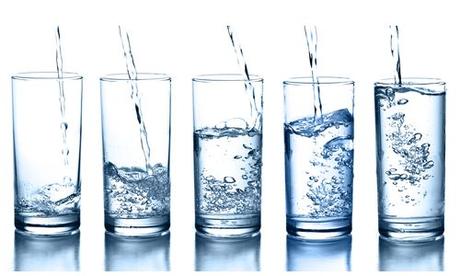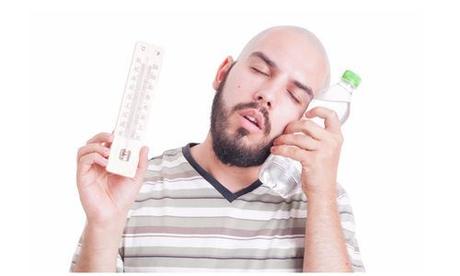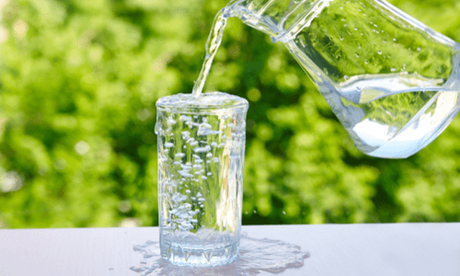
According to most estimates, the human body is made up of at least 60% water.
Given the fact that so much of our bodies consist of water, it’s essential that we maintain a good hydration level.
This is achieved by consuming the required amount of water in order to replace the fluids we lose during the day through sweat, human waste, and respiration or breathing.
But, how much water do we need to drink in order to maintain proper hydration?
Research has shown that the ideal water intake for a healthy adult male is 3.7 L per day, and slightly lower for women at around 2.7 L per day.Men typically require more water than women due to the simple fact that they usually have a greater amount of lean tissue, thereby expending more energy on a daily basis.
Additionally, there are a number of factors that can increase the amount of water a man or woman needs each day. These factors include:
- age
- weight
- level of physical activity
- physiological condition
- external environmental factors such as temperature and humidity
Water Intake Calculator
daily Water intake calculator
Metric require Standard requireAge 14-18 19-30 31-50 50+ Sex Male Female
Height require Weight require
Season Winter Normal Summer Activity Level Lightly Active Moderately Active Very Active
You should drink ...... of water per day
When You Need More Water
As mentioned, there are several factors that can increase a person’s water needs from the baseline levels stated above. According to the World Health Organizations (WHO) guidelines for water intake, the following is a list of key factors that can cause an increased need for water:
Weather
Perhaps, the most prevalent factor that affects water requirements is hot and humid weather, which is something you should pay particular attention to during the summer months. The summer season has increased temperatures, which can dehydrate you quicker if you are working or being physically active outdoors during the summer heat. With increased sweat, due to higher temps, comes increased chances of dehydration and an increased need for proper water consumption.
A great deal of research has been conducted in this area, including observations of forest workers using manual labor methods in the temperature conditions of Zimbabwe. Findings suggested that individuals engaging in heavy physical activity of this kind can require at least 5 L of water per day. So, if you are working in hot, humid conditions then it’s best that you add at least another liter of water per day to the baseline recommendation.
Athletes
A similar water intake approach also applies to those of you who are very physically active in an athletic capacity, particularly if you engage in high intensity workouts. Sweating can result in the loss of electrolytes and as much as 3 – 4 L of fluids per hour depending on some of the other factors we discussed like age and physical conditioning.
The WHO recommends that athletes rehydrate themselves with 1 L of water per 1kg lost from their athletic training or competition.
Items like LYTEshow, are designed to rapidly replenish electrolytes and they do so without adding extra calories, carbs, sweeteners, or artificial preservatives to the liquid drink.
Pregnancy
Your physical condition itself will heavily dictate how much water you should consume. The European Food Safety Authority (EFSA) recommends that water consumption be proportionally increased as weight and calories consumed are increased throughout pregnancy.
For example, if you consume 300 calories more per day during your pregnancy, then you should consume 300 ml of water more per day.
For those who are lactating, the EFSA recommends consuming another 600 to 700 ml per day in order to compensate for loss of fluids.
Obesity
Furthermore, if you are overweight or obese then your water requirements will typically be higher than the average individual because of the larger surface area of your body. On this basis it is recommended that you consume 30 – 40 ml per kg of bodyweight to stay adequately hydrated. This places a 300 lbs individual’s water requirements at approximately 4.8 L per day.
Additionally, two studies have directly linked a lack of proper hydration with obesity. The first study, which was published in the July-August edition of the Annals of Family Medicine, found that people with higher BMIs (obesity) weren’t as “adequately hydrated” as those who had healthier BMIs. It was speculated that obese people didn’t consume enough water, instead they consumed more unhealthy calories.
The second study, which was published in Obesity, found that obese/overweight individuals lost more weight drinking water prior to meals than those who didn’t. These subjects were required to drink 16 ounces of water 30 minutes prior to their meals. Over a 12 week period, they ended up losing 9 pounds because of this practice, and they lost 3 more pounds than those who didn’t drink water prior to their meals.
So, not only does a higher body weight and BMI require more water to stay adequately hydrated, but proper hydration is also believed to prevent obesity and lead to weight loss.
Sick
When you are sick, particularly with a stomach bug or diarrhea, you run the risk of dehydration due to not being able to keep anything down or constantly expelling fluids. So, that means you will probably fall well below the baseline recommendation of water intake per day.
Ideally, you will want to start consuming liquids as soon as possible. However, that’s not always the cases especially when you are still in the extreme vomiting stages.
If possible, doctors recommend that you try to consume 2-4 ounces of fluids ever 2-4 hours. This may mean you have to water down Gatorade in order to get some much needed electrolytes as well.
Dehydration and its Scary Effects

The Mayo Clinic defines dehydration as the point where the body doesn’t have enough water or fluids to perform its normal functions. Returning to the WHO guidelines from above, we learn that thirst is a lagging indicator that truly indicates that your body is already 1% dehydrated.
The sensation of thirst will increase considerably once your body reaches 2% dehydration and dry mouth begins by time you reach 3% dehydration. Unfortunately, it only gets worse from here on out, according to the World Health Organization:
- At 5% dehydration, it may become difficult to concentrate or you can experience a headache and increased tiredness.
- At 6% dehydration, tingling and numbness of the extremities occurs.
- Fainting or collapsing can be seen once you hit 7% dehydration.
- Life threatening issues begin at 10% dehydration.
Once you reach the 5 to 7% threshold of dehydration, you may also experience: a drop in blood pressure, increased or rapid heart rate, a severe fever, sinking of the skin, and seizures.
According to emedicinehealth.com, it’s important to seek medical attention for dehydration once an affected person starts experiencing any of the following:
- Vomiting for more than 1 day
- Diarrhea for at least 2 days
- Decreased amount of urine
- Prolonged weakness
- Fever between 101 F and 103 F (in combination with other factors)
Overhydration (Hyperhydration) – How much water is too much?

As harmful as dehydration can be, the other end of the scale can be equally dangerous. To the surprise of some of you, overhydration is a real condition and can be fatal in extreme situations.
According to one source, overhydration may occur when people drink more water than their body needs.
As little as 2% overhydration can be dangerous, resulting in generalized edema that can affect your physical and even mental performance. Consistent overhydration can potentially place greater strain on your kidneys, while also depleting your body of essential minerals such as sodium. The low levels of sodium in the blood (hyponatremia) can be life threatening.
It’s important to differentiate between drinking large amounts of water and drinking extreme amounts of water that lead to overhydration. Typically, the body is capable of handling and excreting large amounts of water.
The Merc Manual states that you would have to drink more than 6 gallons of water per day on a regular basis for the body not to be able to properly excrete this water.There are medical conditions that can also lead to the body not being able to properly excrete water and lead to overhydration. In conditions like an improper secretion of hormones from the pituitary gland, the kidneys may be told to conserve water instead of excreting it. Some antidepressants and kidney or liver disorders may also cause overhydration.
Overhydration can cause the following symptoms:
- Vomiting
- Loss of balance
- Lethargy
- Confusion
If overhydration worsens from the conditions above, they could lead to seizures or comas. If you suspect that you or another individual is suffering from overhydration, and any of the symptoms above are present, it’s highly advised to seek medical assistance right away.
Do you need to worry about Exact Water Intake?
Research shows that our brains are generally very effective at telling us when it’s time to drink some water. Typically, this is through the various degrees of thirst. Now, as we mentioned above, thirst can mean you’re already experience dehydration.
But, our brains do signal to our bodies that it’s time for water prior to even feeling thirst. So, it’s important to pay attention to the signs that you might need something to drink prior to that feeling of thirst setting in.
Another strong indicator of adequate hydration is your urine. This involves either the color or the volume of your urine. A urine output of roughly 100 mL/h is considered healthy, while anything >300 to <30 mL/h can indicate either dehydration or overhydration.
Unfortunately for most people, we don’t have a desire or the means to measure our volume of urine.
So, the next best indicator for proper water intake levels is the color of urine.
Medical professionals believe that the color of your urine can tell a lot about the body including hydration levels. The following is a summary of urine colors and what they indicate in regards to hydration:
What Your Urine Color Say About Your HydrationTransparent color can signal that you are drinking a lot of water and that you can cut back a little.A pale straw color means you are healthy and properly hydrated. A transparent yellow color means that you are normal. Dark yellow is a good indicator that you need to drink some water soon. A honey color means that your body is not getting enough water. If your urine has a color that looks like syrup then you could be experiencing severe dehydration.The following colors signal an immediate cause for concern and the need to contact your doctor:
Pinkish colored urine either signals that you have eaten beets and related items or that you have blood in your urine. It could also be a sign that you have an infection, prostate problems for men, tumors, or kidney disease.Orange colored urine not only signals that you need more water asap, but it can also signal that you have problems with your bile duct or liver.The following colors signal an immediate cause for concern and the need to contact your doctor:
So, not only do we have signals of thirst and urine output as indicators of adequate hydration, but if we are meeting our baseline water recommendations from above and eating a healthy diet then there’s nothing to worry about.
A well-balance and nutritious diet is filled with fruits and vegetables, which can equate to roughly 20% of our needed water intake per day.We do recommend that you be mindful of your water intake throughout the day especially if you are busy, distracted, or experiencing any of the other factors listed above.
Tips to Stay Hydrated
Simply drinking more water is the most obvious piece of advice we can give you to help you stay hydrated, but timing is also important so be sure to drink plenty of water before, during and after exercise to account for fluids lost through perspiration and respiration.
The following are few more tips that you might not already know:
Tip #1
Our bodies lose a considerable amount of water while we sleep at night, so drinking water immediately before going to bed and first thing in the morning is a great habit to develop. The blood is most of viscous when we first wake up in the morning, and this is when we are at greatest risk of strokes and heart attacks. With this in mind, it is sound advice to replace your morning cup of coffee with a large glass of water instead.
Tip #2
As far as taste is concerned, this is a somewhat subjective matter; however, research has found that acidic flavors such as those attributed to citrus fruits like lemons and limes tend to be most closely related with the quenching of thirst. Additionally, studies have shown that eating more fruits and vegetables like watermelon or celery can also help you to stay hydrated by providing more water and combatting electrolyte imbalance. A great way to maximize the hydrating benefits of fruit and water is by using items like a fruit infusion flavor pitcher. This water pitcher infuses fruit right into the water, which allows you to create whatever fruit flavored water that you desire.
Tip #3
If you do find yourself feeling dehydrated and you want to consume fluids that will be rapidly absorbed into your body then again, water tends to be the best option. Despite the claims made by manufacturers of sports drinks, fluids containing additional sugar and salt show only a marginally faster rate of absorption. So, skip the sports drinks and add some fruit to your post-workout water consumption instead. For those of you bored with plain old water, and don’t care for a fruity taste, then explore the option of carbonated water. In fact, with a sparkling water maker, you can create your own carbonated water right from home. It’s easy, fast, and fun to do.

